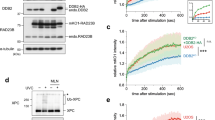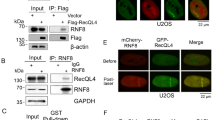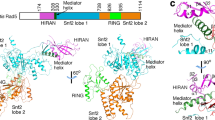Abstract
Rad23 is a nucleotide-excision repair protein with a previously unknown biochemical function. We determined that yeast and human Rad23 inhibited multi-ubiquitin (Ub) chain formation and the degradation of proteolytic substrates. Significantly, Rad23 could be co-precipitated with a substrate that contained a short multi-Ub chain. The UV sensitivity of rad23Δ was reduced in mutants lacking the E2 enzyme Ubc4, or the multi-Ub chain-promoting factor Ufd2. These studies suggest that the stability of proteolytic substrates is governed by the competing action of multi-Ub chain-promoting and chain-inhibiting factors. The stabilization of DNA repair and stress factors could represent an important biological function of Rad23.
This is a preview of subscription content, access via your institution
Access options
Subscribe to this journal
Receive 12 print issues and online access
$209.00 per year
only $17.42 per issue
Buy this article
- Purchase on Springer Link
- Instant access to full article PDF
Prices may be subject to local taxes which are calculated during checkout






Similar content being viewed by others
References
de Laat, W. L., Jaspers, N. G. J. & Hoeijmakers, J. H. J. Molecular mechanism of nucleotide excision repair. Genes Dev. 13, 768–785 (1999).
Prakash, S., Sung, P. & Prakash, L. DNA repair genes and proteins of Saccharomyces cerevisiae. Annu. Rev. Genet. 27, 33–70 (1993).
Guzder, S. N., Sung, P., Prakash, L. & Prakash, S. Affinity of yeast nucleotide excision repair factor 2, consisting of the Rad4 and Rad23 proteins, for ultraviolet damaged DNA. J. Biol. Chem. 273, 31541–31546 (1998).
Jansen, L. E. T., Verhage, R. A. & Brouwer, J. Preferential binding of yeast Rad4–Rad23 complex to damaged DNA. J. Biol. Chem. 273, 33111–33114 (1998).
Guzder, S. M., Bailly, V., Sung, P., Prakash, L. & Prakash, S. Yeast DNA repair protein RAD23 promotes complex formation between transcription factor TFIIH and DNA damage recognition factor RAD14. J. Biol. Chem. 270, 8385–8388 (1995).
Guzder, S. N., Habraken, Y., Sung, P., Prakash, L. & Prakash, S. Reconstitution of yeast nucleotide excision repair with purified Rad proteins, Replication Protein A, and transcription factor TFIIH. J. Biol. Chem. 270, 12973–12976 (1995).
Guzder, S. N., Sung, P., Prakash, L. & Prakash, S. Nucleotide excision repair in yeast is mediated by sequential assembly of repair factors and not by a pre-assembled repairosome. J. Biol. Chem. 271, 8903–8910 (1996).
Sugasawa, K. et al. HHR23B, a human Rad23 homolog, stimulates XPC protein in nucleotide excision repair in vitro. Mol. Cell. Biol. 16, 4852–4861 (1996).
Schauber, C. et al. Rad23 links DNA repair to the ubiquitin/proteasome pathway. Nature 391, 715–718 (1998).
Watkins, J. F., Sung, P., Prakash, L. & Prakash, S. The Saccharomyces cerevisiae DNA repair gene RAD23 encodes a nuclear protein containing a ubiquitin-like domain required for biological function. Mol. Cell. Biol. 13, 7757–7765 (1993).
Lambertson, D., Chen, L. & Madura, K. Pleiotropic growth and proteolytic defects caused by the loss of the proteasome-interacting factors Rad23 and Rpn10 of Saccharomyces cerevisiae. Genetics 153, 69–79 (1999).
van Nocker, S. et al. The multiubiquitin-chain-binding protein Mcb1 is a component of the 26S proteasome in Saccharomyces cerevisiae and plays a nonessential, substrate-specific role in protein turnover. Mol. Cell. Biol. 16, 6020–6028 (1996).
Madura, K. & Varshavsky, A. Degradation of Gα by the N-end rule pathway. Science 265, 1454–1458 (1994).
Morrison, A., Miller, E. J. & Prakash, L. Domain structure and functional analysis of the carboxy-terminal polyacidic sequence of the RAD6 protein of Saccharomyces cerevisiae. Mol. Cell. Biol. 8, 1179–1185 (1988).
Picologlou, S., Brown, N. & Liebman, S.W. Mutations in RAD6, a yeast gene encoding a ubiquitin-conjugating enzyme, stimulate retrotransposition. Mol. Gen. Genet. 218, 465–474 (1990).
Dohmen, R. J., Madura, K., Bartel, B. & Varshavsky, A. The N-end rule is mediated by the Ubc2 (Rad6) ubiquitin-conjugating enzyme. Proc. Natl Acad. Sci., USA. 88, 7351–7355 (1991).
Nuang, H., Kahana, A., Gottschling, D. E., Prakash, L. & Liebman, S. The ubiquitin-conjugating enzyme Rad6 (Ubc2) is required for silencing in Saccharomyces cerevisiae. Mol. Cell. Biol. 17, 6693–6699 (1997).
Byrd, C., Turner, G. C. & Varshavsky, A. The N-end rule pathway controls the import of peptides through degradation of a transcriptional repressor. EMBO J. 17, 269–277 (1998).
Robzyk, K., Recht, J. & Osley, M. A. Rad6-dependent ubiquitination of histone H2B in yeast. Science 287, 501–504 (2000).
Biggins, S., Ivanovska, I. & Rose, R. D. Yeast ubiquitin-like genes are involved in duplication of the microtubule organizing center. J. Cell Biol. 133, 1331–1346 (1996).
van der Spek, P.J. et al. Cloning, comparative mapping, and RNA expression of the mouse homologues of the Saccharomyces cerevisiae nucleotide excision repair gene RAD23. Genomics 31, 20–27 (1996).
Sung, P., Prakash, S. & Prakash, L. The RAD6 protein of Saccharomyces cerevisiae polyubiquitinates histones, and its acidic domain mediates this activity. Genes & Dev. 2, 1476–1485 (1988).
Hershko, A. & Heller, H. Occurrence of a polyubiquitin structure in ubiquitin-protein conjugates. Biochem. Biophys. Res. Comm. 128, 1079–1086 (1985).
Thrower, J. S., Hoffman, L., Rechsteiner, M. & Pickart, C. M. Recognition of the polyubiquitin proteolytic signal. EMBO J. 19, 94–102 (2000).
He, Z., Wong, J. M. S., Maniar, H. S., Brill, S. J. and Ingles, C. J. Assessing the requirements for nucleotide excision repair proteins of Saccharomyces cerevisiae in an in vitro system. J. Biol. Chem. 271, 28243–28249 (1996).
Mu, D., Wakasugi, M., Hsu, D. S. & Sancar, A. Characterization of reaction intermediates of human excision repair nuclease. J. Biol. Chem. 272, 28971–28979 (1997.).
Bachmair, A., Finley, D. & Varshavsky, A. In vivo half-life of a protein is a function of its amino-terminal residue. Science 234, 179–186 (1986).
Varshavsky, A. The N-end rule. Cell 69, 725–735 (1992).
Johnson, E. S., Ma, P. C. M., Ota, I. M. & Varshavsky, A. A proteolytic pathway that recognizes ubiquitin as a degradation signal. J. Biol. Chem. 270, 17442–17456 (1995).
Koegl, M. et al. A novel ubiquitination factor, E4, is involved in multiubiquitin chain assembly. Cell 96, 635–644 (1999).
Russell, S. J., Reed, S. H., Huang, W., Friedberg, E. C. & Johnston, S. A. The 19S regulatory complex of the proteasome functions independently of proteolysis in nucleotide excision repair. Mol. Cell 3, 687–695 (1999).
Hiyama, H. et al. Interaction of hHR23 with S5a. The ubiquitin-like domain of hHR23 mediates interaction with S5a subunit of 26S proteasome. J. Biol. Chem. 274, 28019–28025 (1999).
Funakoshi, M., Geley, S., Hunt, T., Nishimoto, T. & Kobayashi, H. Identification of XDRP1; a Xenopus protein related to yeast Dsk2 binds to the N-terminus of cyclin A and inhibits its degradation. EMBO J. 18, 5009–5018 (1999).
Sugasawa, K. et al. Xeroderma pigmentosum group C protein complex is the initiator of global nucleotide excision repair. Mol. Cell 2, 223–232 (1998).
Masutani, C. et al. Purification and cloning of a nucleotide excision repair complex involving the xeroderma pigmentosum group C protein and a human homologue of yeast RAD23. EMBO J. 13, 1831–1843 (1994).
Seol, J. H. et al. Cdc53/cullin and the essential Hrt1 RING-H2 subunit of SCF define a ubiquitin ligase module that activates the E2 enzyme Cdc34. Genes Dev. 13, 1614–1626 (1999).
Xie, Y. & Varshavsky, A. The E2–E3 interaction in the N-end rule pathway: the RING-H2 finger of E3 is required for the synthesis of multiubiquitin chain. EMBO J 18, 6832–6844 (1999).
Pickart, C. M. Targeting of substrates to the 26S proteasome. FASEB J. 11, 1055–1066 (1997).
Chen, P., Johnson, P., Sommer, T., Jentsch, S. & Hochstrasser, M. Multiple ubiquitin-conjugating enzymes participate in the in vivo degradation of the yeast MATα2 repressor. Cell 74, 357–369 (1993).
Tongaonkar, P. & Madura, K. Reconstituting ubiquitination reactions with affinity-purified components and 32P-ubiquitin. Anal. Biochem. 260, 307–319 (1998).
Chen, Z., Niles, E. G. & Pickart, C. M. Isolation of a cDNA encoding a mammalian multiubiquitinating enzyme (E2 25K) and overexpression of the functional enzyme in Escherichia coli. J. Biol. Chem. 265, 15698–15704 (1991).
Gietz, R. D. & Sugino, A. New yeast–Escherichia coli shuttle vectors constructed with in vitro mutagenized yeast genes lacking six-base pair restriction sites. Gene 74, 527–534 (1988).
Hodgins, R., Gwozd, C., Arnason, T., Cummings, M. & Ellison, M. J. The tail of a ubiquitin-conjugating enzyme redirects multi-ubiquitin chain synthesis from the lysine 48-linked configuration to a novel nonlysine-linked form. J. Biol. Chem. 271, 28766–28771 (1996).
You, J., Cohen, R. E. & Pickart, C. M. Construct for high-level expression and low misincorporation of lysine for arginine during expression of pET-encoded eukaryotic proteins in Escherichia coli. Biotechniques 27, 2–6 (1999).
Bartel, B., Wunning, I. & Varshavsky, A. The recognition component of the N-end rule pathway. EMBO J. 9, 3179–3189 (1990).
Acknowledgements
We thank I. Vega for recombinant Rad23 protein and for constructing a plasmid that expressed ΔUbLrad23. We also thank J. Huibregtse for providing reagents to examine the effect of Rad23 on Rsp5-mediated ubiquitination in rabbit reticulocyte lysates, D. Stern for the GST–Spk1 construct and C. Pickart for plasmids pGEX-E2-25K and pJY2. M. Ellison, M. Hochstrasser and D. Gietz are thanked for providing plasmids and strains. K. Sweder is thanked for assistance with the NIH Scan densitometry analysis. D.L. was supported by a pre-doctoral fellowship from the American Heart Association (9810001T). C.S. was supported by Postdoctoral Fellowships from the Robert Wood Johnson Foundation and New Jersey Commission on Cancer Research (98-2005-CCR-00). These studies were supported by grants to K.M. from the National Institutes of Health (GM-RO1-52058) and the Cancer Institute of New Jersey (561735). K.M. is a member of the Cancer Institute of New Jersey.
Author information
Authors and Affiliations
Corresponding author
Rights and permissions
About this article
Cite this article
Ortolan, T., Tongaonkar, P., Lambertson, D. et al. The DNA repair protein Rad23 is a negative regulator of multi-ubiquitin chain assembly. Nat Cell Biol 2, 601–608 (2000). https://doi.org/10.1038/35023547
Received:
Revised:
Accepted:
Published:
Issue Date:
DOI: https://doi.org/10.1038/35023547
This article is cited by
-
Arabidopsis thaliana ubiquitin-associated protein 2 (AtUAP2) functions as an E4 ubiquitin factor and negatively modulates dehydration stress response
Plant Molecular Biology (2024)
-
Proteomic basis of mortality resilience mediated by FOXO3 longevity genotype
GeroScience (2023)
-
Structure of HIV-1 Vpr in complex with the human nucleotide excision repair protein hHR23A
Nature Communications (2021)
-
Comprehensive profiling of lysine ubiquitome reveals diverse functions of lysine ubiquitination in common wheat
Scientific Reports (2017)
-
The life cycle of the 26S proteasome: from birth, through regulation and function, and onto its death
Cell Research (2016)



